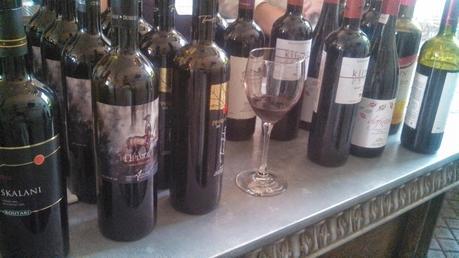 The historical origins of wine oscillates between the Caucasus Mountains and the Eastern Mediterranean, but there's little doubt on the historical contributions from the Island of Crete. Whether distributed by the Minoans, Phoenicis, Romans, or Venetians; Crete was the dominate producers in the Eastern and Western Mediterranean. The Egyptian Pharoahs drank Cretan wine, as did Homer, the Romans, and rulers of Greek Byzantine. This domination stalled when the Ottoman Empire conquered the island, followed by years of political post WWII political turmoil. Today the Wines of Crete are rebounding primarily through the return of native grapes and wine making traditions.There are currently thirty plus wineries operating with most of the vineyards in the central region of Heraklion or eastern Lasithi. The former includes three Protected Designation of Origin (Dafnes, Archanes, Peza) and the later one (Sitia).
The historical origins of wine oscillates between the Caucasus Mountains and the Eastern Mediterranean, but there's little doubt on the historical contributions from the Island of Crete. Whether distributed by the Minoans, Phoenicis, Romans, or Venetians; Crete was the dominate producers in the Eastern and Western Mediterranean. The Egyptian Pharoahs drank Cretan wine, as did Homer, the Romans, and rulers of Greek Byzantine. This domination stalled when the Ottoman Empire conquered the island, followed by years of political post WWII political turmoil. Today the Wines of Crete are rebounding primarily through the return of native grapes and wine making traditions.There are currently thirty plus wineries operating with most of the vineyards in the central region of Heraklion or eastern Lasithi. The former includes three Protected Designation of Origin (Dafnes, Archanes, Peza) and the later one (Sitia). A national marketing campaign is promoting this recovery by providing tasting sessions in various cities in the United States and Europe. I attended a session in Washington DC at the very cool Iron Gate Restaurant. The session was lead by @1winedude +Joe Roberts, who had an extensive visit with the island's wineries a couple years back. Joe described many of the native grape varieties while leading our large group through a blind tasting panel.
A national marketing campaign is promoting this recovery by providing tasting sessions in various cities in the United States and Europe. I attended a session in Washington DC at the very cool Iron Gate Restaurant. The session was lead by @1winedude +Joe Roberts, who had an extensive visit with the island's wineries a couple years back. Joe described many of the native grape varieties while leading our large group through a blind tasting panel.  Starting with whites, the two major players are Vidiano and Vilana with contributions from Plyto, Dafni, Thrapsathiri, Muscat Spina, and Malvazia. Vidiano wines exhibit a peach and apricot profile which reminded many of Albarino. Vilana grapes contribute lemon acids and floral aromas to blends.
Starting with whites, the two major players are Vidiano and Vilana with contributions from Plyto, Dafni, Thrapsathiri, Muscat Spina, and Malvazia. Vidiano wines exhibit a peach and apricot profile which reminded many of Albarino. Vilana grapes contribute lemon acids and floral aromas to blends.For reds, Kotsifali is the primary indigenous grape, with some international varieties like Syrah and Cabernet Sauvignon in play. Other indigenous red grapes are Liatiko, Mandilari, and Romeiko. One of my favorites of the tasting panel was the Boutari Skalani, a Kotsifali- Syrah blend, very earthy, dusty with dark black fruit flavor and aroma.

 After the official blind tasting, our hosts were kind enough to offer an open bar of 23 Cretan wines. Being a Santorini freak, I enjoyed the Mediterra Assyrtiko as well as the Anoskeli Ano Playa Rose - perhaps a bleed of their Ano Plagia (Syrah, Grenache Rouge, Cabernet Sauvignon). For reds, I turned to the wines from two winemakers who Alexandra Manousakis and Maria Titaki. Ms. Manousakis actually grew up in Washington DC, but eventually returned to Crete when her father started planting Rhone varieties in his native island. The 2008 Manousakis Nostos (Syrah, Grenache, Mouvedre) was quite nice - full of creamy berries and good acids. The Titakis Vin de Crete is a fruit forward, easy drinking wine, with smooth tannins, and although I don't have the office retail price - rumor says quite inexpensive.
After the official blind tasting, our hosts were kind enough to offer an open bar of 23 Cretan wines. Being a Santorini freak, I enjoyed the Mediterra Assyrtiko as well as the Anoskeli Ano Playa Rose - perhaps a bleed of their Ano Plagia (Syrah, Grenache Rouge, Cabernet Sauvignon). For reds, I turned to the wines from two winemakers who Alexandra Manousakis and Maria Titaki. Ms. Manousakis actually grew up in Washington DC, but eventually returned to Crete when her father started planting Rhone varieties in his native island. The 2008 Manousakis Nostos (Syrah, Grenache, Mouvedre) was quite nice - full of creamy berries and good acids. The Titakis Vin de Crete is a fruit forward, easy drinking wine, with smooth tannins, and although I don't have the office retail price - rumor says quite inexpensive. So once again Greek wines impress with their quality and presumed affordability. Expand your horizons and check out these historic wines. Cheers.
